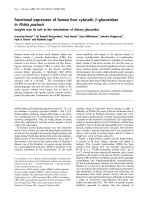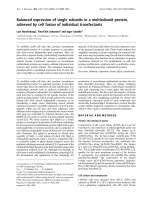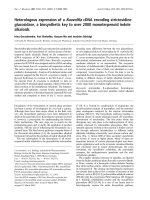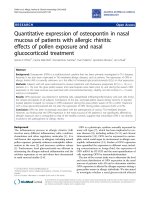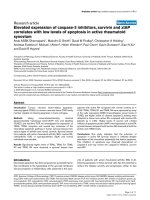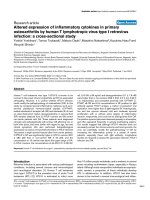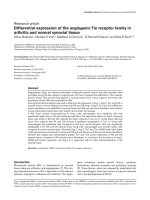Báo cáo Y học: The expression of glutathione reductase in the male reproductive system of rats supports the enzymatic basis of glutathione function in spermatogenesis doc
Bạn đang xem bản rút gọn của tài liệu. Xem và tải ngay bản đầy đủ của tài liệu tại đây (475.16 KB, 9 trang )
The expression of glutathione reductase in the male reproductive
system of rats supports the enzymatic basis of glutathione function
in spermatogenesis
Tomoko Kaneko
1,2
, Yoshihito Iuchi
1
, Takashi Kobayashi
1,3
, Tsuneko Fujii
4
, Hidekazu Saito
2
,
Hirohisa Kurachi
2
and Junichi Fujii
1
Departments of
1
Biochemistry,
2
Obstetrics and Gynecology, and
3
Urology, Yamagata University School of Medicine, Yamagata,
Japan;
4
Cell Recovery Mechanisms, RIKEN Brain Science Institute, Japan
Glutathione reductase (GR) recycles oxidized glutathione
(GSSG) by converting it to the reduced form (GSH) using
an NADPH as the electron source. The function of GR in
the male genital tract of the rat was examined by meas-
uring its enzymatic activity and examining the gene
expression and localization of the protein. Levels of GR
activity, the protein, and the corresponding mRNA were
the highest in epididymis among testes, vas deferens,
seminal vesicle, and prostate gland. The l ocalization of
GR, as evidenced by immunohistochemical techniques,
reveals that it exists at high levels in the epithelia of the
genital tract. In testis, GR is mainly localized in Sertoli
cells. The enzymatic activity and protein expression of GR
in primary cultu red testicular cells confirmed its predom-
inant expression in Sertoli cells. Intracellular GSH levels,
expressed as mol per mg protein, was higher in sperma-
togenic cells than in Serto li cells. As a result of these
findings, the effects of buthionine sulfoximine (BSO), an
inhibitor f or GSH synthesis, a nd 1,3-bis(2-chlorethyl)-1-
nitrosourea (B CNU), a n inhibitor f or GR, on c ultured
testicular cells were examined. Sertoli cells were prone to
die as the result of BCNU, but not BSO treatment, al-
though intracellular levels of GSH declined more severely
with BSO treatment. Spermato genic cells were less sensitive
to these agents than Sertoli cells, which indicates that the
contribution of these enzymes is less significant in sper-
matogenic cells. The results herein suggest that the GR
system in Sertoli cells is involved in the supplementation of
GSH to spermatoge nic cells in which high levels of cysteine
are required for protamine synthesis. In turn, the genital
tract, the epithelia of which are rich in GR, functions in an
antioxidative manner to protect sulfhydryl groups and
unsaturated fatty acids in spermatozoa from oxidation
during the maturation process and storage.
Keywords: glutathione reductase; spermatogenic cell; Sertoli
cells; spermatozoa; epididymis.
Oxidation affects the spermatozoa in complex ways; either
triggering hyperactivation or the suppression of motility
largely d epending on conditions [1–3]. The quality of
spermatozoa can be evaluated using reagents that distin-
guish oxidized thiols from others [4]. Thiol oxidation occurs
in the nuclei and the tail during the maturation process in
the epididymis. The greater the extent of oxidation in nuclei,
the more potent are the spermatozoa. In addition, hyper-
activation of spermatozoa is triggered by reactive oxygen
species (ROS) [1,5]. On the other hand, oxidation by ROS
has been reported to decrease sperm motility [6,7]. Thus, the
effects of ROS on spermatozoa are both beneficial and
detrimental. In human spermatozoa, 40% by weight of
the total fatty acid fraction is composed of polyunsaturated
fatty acids, which, in turn, enable spermatozoa t o be more
motile [8]. Docosahexaenoic acid comprises more than 60%
of the total polyunsaturated fatty acids [9]. As polyunsat-
urated fatty acids are vulnerable to peroxidation by ROS,
and peroxidized lipids and carbonyl compounds produced
by this reaction are toxic to spermatozoa [10,11], protection
against oxidative stress is prerequisite for the production of
functional sperm.
Glutathione has pleiotropic roles, which include the
maintenance of cells in a reduced state, serving as an
electron donor for certain antioxidative enzymes, and the
formation of conjugates with some harmful endogenous
and xenobiotic compounds via catalysis of glutathione
S-transferase [12]. Levels of the reduced form of glutathione
(GSH) are ma intained by two s ystems. One is de novo
synthesis from b uilding blocks, glutamate, cysteine, and
glycine, via two ATP-con suming s teps involving c-g lut-
amylcysteine synthetase ( cGCS) and glutathione synthetase.
The other constitutes a recycling system involving GR
which reduces oxidized glutathione (GSSG) back to GSH in
an NADPH-d ependent manner. In addition to the direct
interaction of GSH with ROS, GSH serves a s a n e lectron
donor for s ome peroxidases, i ncluding glutathione peroxi-
dase [13] and p eroxiredoxins [14,15]. The resulting o xidation
Correspondence to J. Fujii, Department of Biochemistry, Yamagata
University School of Medicine, 2-2-2 Iida-nishi, Yamagata City,
Yamagata 990-9585, Japan. Fax: + 81 23 628 5230,
Tel.: + 81 23 628 5227, E-mail:
Abbreviations: GR, glutathione reductase; ROS, reactive oxygen
species; GSH, glutathione, reduced form; GSSG, glutathione, oxidized
form, cGCS, c-glutamylcysteine synthetase; DTNB, 5,5¢-dithiobis
(2-nitrobenzoic acid); BSO, buthionine sulfoximine; BCNU, 1,3-bis
[2-chlorethyl]-1-nitrosourea.
Enzyme: glutathione reductase ( EC 1.6.4.2).
(Received 2 October 2001, revised 1 8 January 2002, accepted 23
January 2002)
Eur. J. Biochem. 269, 1570–1578 (2002) Ó FEBS 2002
product, GSSG, is either recycled by GR via electron
transfer from NADPH or pumped out of the cells. Thus,
GR indirectly participates in the protection o f cells against
oxidative stress. The enzymatic activities of GR have been
investigated in various tissues under physiologic and
pathologic conditions [16], but only few reports have
focusedonthelocalizationoftheGRproteinintissues[17].
Significant functions of GSH in spermatogenesis and the
reproductive process have been reported [13]. However, the
reported values for GSH in spermatozoa are controversial
and h ave been reported t o be high in dog, goat, ram, and
human spermatozoa [18], but below detectable levels in the
frog [19], bull [20,21] and rat [22]. Estimation of GR activity
as well as that of glutathione peroxidase has been reported
in mammalian s permatozoa and seminal plasma including
human [7,23,24]. Although t he pivotal role of GSH and its
recycling enzyme in reproductive process is now well
recognized [13], no data has yet been presented that shows
the localization o f GR, histologically, in the male genital
tract.
We reported the localization and estrous-cycle-dependent
induction of GR in the female genital tract in rats [17] using
a specific antibody against rat GR and its cDN A as probe
for R NA analysis [25]. In the present report, the potential
role of GR is e valuated by biochemical as well as
immunohistochemical analyses of the male genital tract in
rats. The results suggest a pivotal role for the GSH/GR
system in spermatogenesis and the maintenance of sperma-
tozoa quality during the maturation process, particularly in
the epididymis.
EXPERIMENTAL PROCEDURES
Materials
GSH and GSSG were purchased from Roche (Mannheim,
Germany). NADPH and yeast GR were obtained from
Oriental Yeast (Tokyo, Japan). 5,5¢-Dithiobis(2-nitroben-
zoic acid) (DTNB) was from Kanto Chemicals (Tokyo,
Japan). 2-Vinylpyridine was from Wako Pure Chemicals
(Osaka, J apan). Buthionine sulfoximine (BSO) and 1,3-
bis[2-chlorethyl]-1-nitrosourea (BCNU) were obtained f rom
ICN and Sigma, respectively. All other reagents used were
of the highest available quality.
Animals
All experiments were performed under protocols approved
by the Animal Research Committee from Yamagata Uni-
versity School of Medicine. Wistar rats, purchased from
Japan SLC, were m aintained under conventional conditions.
Three rats were used for each data point. Tissues, which were
obtained under anesthesia with diethyl ether were either
fixed immediately in B ouin solution for immunohistochem-
ical analysis or frozen under liquid nitrogen and preserved at
)80 °C until used for enzyme and mRNA assays.
Preparation of tissue homogenates and protein assay
Tissues were homogenized in NaCl/P
i
containing
10 lgÆmL
)1
pepstatin, 10 lgÆmL
)1
leupeptin, 100 l
M
phe-
nylmethylsulfonyl fluoride, and 1 m
M
benzamidine with a
Physcotron homogenizer (Nichion, Tokyo, Japan). After
centrifugation at 10 000 g for 20 min, the supernatant was
collected and kept at )20 °C. Protein concentrations were
determined using a BCA kit (Pie rce, Rockford, IL).
Testicular cell culture
Male Wister rats (40–50 days) were killed by diethyl ether
anesthesia, and testicular ce lls were isolated as reported
previously [26]. Briefly, after decapsulation of the testes, the
seminiferous tubules were minced using scissors and incu-
bated i n NaCl/P
i
containing 0.25 % type I collagenase
(Wako, Osaka, Japan) at 32.5 °C for 15 min. The semin-
iferous tubules were washed with NaCl/P
i
once and then
incubated in NaCl/P
i
containing 0.25% trypsin (Difco,
Detroit, MI, USA) at 32.5 °C for 15 min. After the addition
of fetal bovine serum to a concentration of 1 0%, the cell
suspension was fi ltered through n ylon mesh to remove
aggregates and t issue d ebris. The cells were cultured in an
equal mixture of F12-L15 medium s upplemented with
100 U ÆmL
)1
penicillin G, 100 lgÆmL
)1
streptomycin,
15 m
M
Hepes (pH 7.3), and 10% fetal bovine serum at
32.5 °Cwith5%CO
2
under humidified conditions. After
harvesting the cells with a silicon scraper, they were washed
twice with NaCl/P
i
andsonicatedinanextractionbuffer
(25 m
M
Tris/HCl, pH 7.4, 50 m
M
NaCl, 10 lgÆmL
)1
aprotinin, 10 lgÆmL
)1
leupeptin, and 20 l
M
p-amidi-
nophenylmethanesulfonylfluoride hydrochloride). The
soluble fractions, after centrifugation at 10 000 g for
20 min at 4 °C, were subjected to protein analyses and
enzyme assays.
Enzyme assay
GR activity was determined spectrophotometrically by
measuring the rate of NADPH oxidation at 340 nm [16].
The reaction m ixture consisted of 0.1
M
potassium phos-
phate,pH7.0,1m
M
EDTA, 0.1 m
M
NADPH, 1 m
M
GSSG, and tissue samples. The decrease in absorbance at
340 nm at room temperature was recorded. As the decrease
in absorbance for the control reaction mixture without
GSSG or tissue sample was negligible, the contribution o f
spontaneous NADPH oxidation and other red uctases in the
samples can be ignored. One unit of GR activity was d efined
as the amount of enzyme that catalyzes the oxidation of
1 lmol of NADPH per min. All assays were performed on
triplicate samples, and means ± SD are reported.
Measurement of total glutathione and GSSG
Total g lutathione and G SSG were determined by the
recycling method described by Anderson [27]. Briefly,
cultured cells were collec ted and washed t wice with NaCl/
P
i
. The precipitated cells were sonicated in 5% 5-sulfosul-
icylic acid. After centrifugation a t 8000 g for 10 min, the
supernatant (25 lL) was applied to a reaction mixture
containing 100 m
M
sodium phosphate buffer, 5 m
M
EDTA,
200 U ÆmL
)1
yeast GR, 0.1 m
M
NADPH, and 5 m
M
DTNB. The absorbance at 412 nm was continuously
recorded using a spectrophotometer. For GSSG quantifi-
cation, free thiols in the samples were derivatized with
2-vinylpyridine and subjected to the recycling assay. The
concentrations of total g lutathione and GSSG were calcu-
lated from the absorbance change using authentic GSH and
Ó FEBS 2002 Glutathione reductase in male reproduction system (Eur. J. Biochem. 269) 1571
GSSG as a standard and the data are expressed as nmolÆmg
protein
)1
.
SDS/PAGE and Western blot analysis
Protein samples were subjected to 10% SDS/PAGE [28] and
then transferred onto Hybond-P (Amersham Pharmacia,
Pscataway, NJ, U SA) under semi-dry conditions by means
of a Transfer-blot SD Semi-dry transfer cell ( Bio-Rad,
Tokyo, Japan). The membranes were then blocked by
incubation with 5% skimmed milk in NaCl/Tris (20 m
M
Tris/HCl, pH 8.0, and 150 m
M
NaCl) containing 0.1%
Tween-20 for 2 h at room temperature. The membranes
were then incubated with a rabbit anti-(rat GR) Ig (1 : 1000
dilution) [25] or a goat anti-(follicle-stimulating hormone
receptor) Ig (Santa Cruz Biotechnology, Santa Cruz, CA,
USA) fo r 1 2 h a t 4 °C. After washing with NaCl/Tris
containing 0.1% Tween-20, the membranes were incubated
with 1: 1000 diluted peroxidase-conjugated goat anti-(rabbit
IgG) Ig (Santa Cruz Biotechnology, Santa Cruz, CA, USA)
for 1 h. Following the washing, p eroxidase activity w as
detected by a chemiluminescence method using an ECL Plus
kit (Amersham Pharmacia, Buckinghamshire, UK).
Preparation of total RNA
Total cellular RNAs were isolated from several rat tissues
by homogenization using the guanidine thiocyanate/phenol/
chloroform extraction method [29] using Isogen (Nippon
Gene, T okyo, Japan). The final pellet was dissolved in
diethylpyrocarbonate-treated H
2
O and was quantified by
an absorbance measurement at 260 nm.
Northern blot analysis
Total RNAs, 5 or 10 lg per lane, were electrophoresed on a
1% agarose gel containing 2.2
M
formaldehyde [30]. The
size-fractionated RNAs w ere transferred onto a Hybond-N
membrane (Amersham P harmacia Biotech) by capillary
action. After h ybridization with the
32
P-labeled rat GR
cDNA probe [25] at 42 °C in the presence of 50%
formamide, the membranes were washed twice for 20 min
at 55 °Cin2· NaCl/Cit (1 · NaCl/Cit: 150 m
M
NaCl and
15 m
M
sodium citrate, pH 7.5) containing 0.1% SDS and
then twice in 0.2 · NaCl/Cit. T he Kodak XAR films were
exposed with a n intensifying screen at )80 °C.
Immunohistochemistry
For the immunohistochemical study, the DAKO Envision
System (DAKO Co., Carpinteria, CA, USA) was employed
[31]. This system i s based ona horseradish peroxidase-labeled
polymer that is conjugated with secondary antibodies.
Paraffin-embedded tissue blocks were cut on a microtome
at a thickness of 5-lm and the resulting serial sections were
mounted on silianized slides. After deparaffinization and
rehydration, endogenous peroxidase activity in the
sectioned tissues was in activated with 0.1% hydrogen
peroxide. The target retrieval procedure involves the
immersion of tissue sections in a citrate based buffer
solution and heating in an autoclave. Tissue s ections were
briefly treated with por cine serum for 10 min to b lock
nonspecific binding and then reacted with anti-(rat GR) Ig
for 60 m in at a 1 : 200 dilution. The sections were
sequentially reacted w ith peroxidase-labeled goat anti-
(rabbit IgG) Ig polymer for 3 0 m in, a nd 3,3-diaminobenzi-
dine for 1 min. Nonimmune rabbit IgG (Santa Cruz
Biotechnology, Santa Cruz, CA, USA) was used as a
control. Photographs were taken with a digital camera
under light microscopy (Olympus BX50, Tokyo, Japan).
RESULTS
Levels of GR in male reproductive system of the adult rat
To identify the cells responsible for GSSG reduction, an
attempt was m ade to determine the localization of GR in
the male reproductive system of the rat. We fi rst measured
GR activity in the cytosolic fractions from testes, epididy-
mis, seminal vesicles, vas deferens, and prostate gland in
13-week-old-adult rats (Fig. 1A). The highest activity for
GR was f ound in the epididymis, followed by seminal
vesicles, prostate gland, vas deferens, and testes. GR activity
was negligible in spermatozoa.
To evaluate the levels of these enzymes in tissues and
spermatozoa, a W estern blot analysis was c arried out
(Fig. 1 B) using the anti-(rat GR) Ig. Preincubation of the
tissue extract with this antibody completely abolished GR
activity (data not shown). The 50-kDa band, corresponding
to the GR protein, was observed in a ll tissues except for
spermatozoa. A faint GR band c ould be detected in
spermatozoa only a fter a longer exposure. Thus, the order
of band intensities matched the levels o f enzymatic activity.
A Northern blot analysis of total RNAs extracted from the
same tissues showed some inconsistent results between the
protein and the mRNA for GR (Fig. 1 C), which appears to
be due to different turnover rates of the protein in t hese
tissues.
Immunohistochemical localization of GR
in male reproductive system of the adult rat
We employed immunohistochemical a nalyses of G R in
order to determine its localization in the male rep roductive
system of the adult rat (Fig. 2). Epithelia from the
epididymis, vas deferens, seminal vesicles, and prostate
glands were strongly stained w ith the GR antibody. In the
case of testes, t he immunoreactivity to the anti-GR Ig was
strong in Sertoli cells. Concerning the intracellular distribu-
tion, positive signals to the an tibody were found mainly in
the cytoplasm. However, nuclei of the epithelial cells of the
epididymis and vas deferens were also stained, as has also
been reported in uteri [17].
Activity and expression of GR in primary cultured
spermatogenic and Sertoli cells
To identify cells that express GR more clearly, testicular
cells were separated under the culture con ditions. As Sertoli
cells bec ome attached to conventional plastic plates at 24 h
after separation a nd grow, but spermatogenic cells do not,
they could be separated by transferring the culture medium
containing floating cells [32]. The attached cells were
confirmed as Sertoli cells by Western blot analysis using
an antibody against the follicle-stimulating hormone recep-
tor (data not shown). The attached cells were spread and
1572 T. Kaneko et al. (Eur. J. Biochem. 269) Ó FEBS 2002
amorphous, and, thus, consistent with the shape of Sertoli
cells, while the floating cells did not become attached to the
dishes and were round and variable in size ( data not shown).
Figure 3A shows the GR activity of the separated cells. The
GR activity in Sertoli cells was about eightfold higher than
that of the spermatogenic cells. A Western blot of proteins
from both cells indicated that GR, 50 kDa in size, was
expressed in the Sertoli cells, but was below the detectable
levels in spermatogenic cells (Fig. 3B). Thus, a high
expression of GR in Sertoli cells can b e fully confirmed.
Changes of GR expression in testes
during sexual maturation
To examine relationships between the expression of GR
with sexual maturation, Western blot and Northern blot
analyses as well as an enzyme assay w ere carried out on
testes from premeiotic stage (14 days), meiotic stage
(21 d ays), early haploid stage (25 days), and late round/
elongating spermatid stage (30 days) [33] and 13-week-old
adult rats (Fig. 4). The highest activity was found in the
youngest rats at 14 days of age. GR has complex charac-
teristics and has both active and inactive states that are
interchangeable by redox conditions. As oxidation of the
enzyme makes its activity low, GR may be kept in the
oxidized form in the developed rats. Concerning expression
in Sertoli c ells, no d ifference was observed during this period
by immunohistochemistry (data not shown). As the activity
difference was small, the difference i n intensity of the bands
for the protein and the mRNA were faint.
Effects of inhibitors of cGCS and GR
on primary cultured testicular cells
To investigate t he contribution of de novo synthesis and the
recycling of GSH to the intracellular g lutathione pool, the
Fig. 2. Immunohistochemical localization of GR in the male reproduc-
tion system of adult rats. Sections of an adult male rat were treated with
1 : 200 dilution of anti-GR Ig. Photographs were taken with a digital
camera using light microscopy; 130· magnification: ( A) testis;
(C) epididymis, head; (E) epididymis, tail; (F) vas deferens; (G) seminal
vesicle; (H) p rostate gland. 650· magnification: (B) testis; ( D) epidi-
dymis, head.
Fig. 1. GR activities, protein, and mRNA levels in the m ale repro-
duction system of adult rats. (A) Enzymatic activities of 90 lg
cytosolic proteins from five organs and spermatozoa of 13-week-old-
rats were measured in a 1-mL cuvette. Data a re presented as the
means ± SD of three rat organ s. (B) Twenty micrograms of soluble
protein was subjected to Western blot analyses with the GR antibody
ata1:1000dilution.Typicaldatafromseveralexperimentsare
shown. Th e a rrowh ead i ndicates the position o f G R (50 kDa).
(C) Total RNAs (10 lg) from rat testes at the indicated ages, which
were separated on a 1% agarose gel.
Ó FEBS 2002 Glutathione reductase in male reproduction system (Eur. J. Biochem. 269) 1573
levels of GSH and GSSG were measured in cultured Sertoli
cells and spermatogenic ce lls after treatment with BSO, an
inhibitor of c-GCS, and BCNU, an inhibitor of GR
(Fig. 5 ). The spermatogenic cells contained GSH levels
which were about twice as high as those of Sertoli cells.
Treatment of Sertoli cells with 100 or 1000 l
M
BCNU
totally inhibited the GR activity (data not shown). After a
24-h incubation, the total glutathione level in the Sertoli cells
was decrease d to 8 and 14% of the control by 10 m
M
BSO
and 1 m
M
BCNU, respectively (Fig. 5A). However, these
agents were less potent to the spermatogenic cells. GSSG
levels increased only s lightly after BCNU tre atment. This is
likely due to the excretion of the GSSG from the cells by a
specific transporter.
We then examined changes in total glutathione levels in
spermatogenic cells up to 3 days after the addition of these
agents (Fig. 5B). Intracellular glutathione levels decreased
spontaneously during the culture period. The presence of
BSO accelerated this decline, but BCNU was not as effec tive
as BSO. The rate of reduction in glutathione levels with
BCNU did not appear to be different from that of the
spontaneous decrease and corresponded to the low level of
GR content in t he spermatogenic cells. W hen morphology
of the cells were observed by a light microscope, a marked
effect was observed only for BCNU-treated Sertoli cells
(Fig. 6 ). Thus, BCNU exerted a more toxic effect on Sertoli
cells than on spermatogenic cells.
DISCUSSION
The findings in t his study show that GR is highly expressed
in epithelial cells of the m ale genital tract, especially in the
Fig. 4. Decrease in the levels of GR in testes around pubertal stages. (A)
Enzymatic activities o f 90 lg cytosolic p roteins from pre- and post-
pubertal as well as adult rat testes were measured. Data are presented
as the means + S D for three rat organs. (B) Ten micrograms of pro-
teins from testes were subjected to Western blot analysis with a
1 : 3000 d ilution of th e anti-GR Ig. (C) Total RNAs (5 lg) from rat
testes at the indicated ages w ere separated on 1% agarose ge l. The
blotted membrane was hybridized with the rat GR cDNA probe.
Fig. 3. GR activity and the protein in primary cultured testicular cells.
Testicular cells were primary cultured from a 5-week-old rat. After
isolation from the seminiferous tubules, the cells were plated on a
conventional 9-cm dishes. After 24 h, unattached spermatogenic cells
were separated from the attached Sertoli cells and cultured for 24 h at
32.5 °C. The Sertoli cells were grown for a further 3 days. Cytosolic
proteins were extracted from the harvested cells. (A) The GR activity
in floated spermatogenic cells (left) and the attached Sertoli cells
(right). (B) Expression of GR was analyzed by Western blot for 10 lg
proteins with the anti-GR Ig.
1574 T. Kaneko et al. (Eur. J. Biochem. 269) Ó FEBS 2002
epididymis, and Sertoli cells in the seminiferous tubules in
the rat (Figs 2 and 3). The specific activity of GR decreased
during sexual maturation in testes, while the total activity
increased (Fig. 4). This can be attributed to the proliferation
of spermatogenic cells around the pubertal stage, and the
reduction in the population of Sertoli cells relative to the
spermatogenic c ells. Even though the GR content was very
low in spermatogenic cells, their GSH levels were somewhat
higher than in the Sertoli cells (Figs 3 and 5). According to
Fig. 5A, the increase in the G SSG level i n BCNU-treated
Sertoli cells did not correspond to the decrease in levels o f
total glutathione. Thus the excretio n of GSSG is only
mechanism for Sertoli cells. M uch weaker effects of BSO
and BCNU on spermatogenic cells suggest that they are
resistant to these reagents with unknown mechanism.
Although GR, glutathione peoxidase and superoxide
dismutase are all present in seminal plasma, with their origin
thought to be the prostate [34], the activity of GR was low in
prostate tissues (Fig. 1 ). It is well known that the matur-
ation of spermatozoa proceeds via oxidation and reduction
processes in the male genital tract, especially in the
epididymis. Disulfide bond formation in p rotamine, a
counter part of histone in sperm nuclei, is required for
packaging the DNA into the small head space a nd to
Fig. 6. Sertoli cell death by BCNU treatment. Morphology of the
Sertoli c ells in Fig. 5 is s hown at 6 h after the addition of BSO or
BCNU. Magnification ¼ 50·.
Fig. 5. Effects of BSO and BCNU on intracellular glutathione levels in
the spermatogenic and Sertoli cells. After isolation from seminiferous
tubules, the cells were cultured fo r 24 h at 32.5 °C. Spermatogenic cells
floating in the culture media were transferred to dishes and were
treated with BSO (10 m
M
)orBCNU(1 m
M
). Sertoli cells were treated
with the same reagents after incubation for 4 d ays. (A) The cells were
harvestedafter24hincubationwiththereagentsandassayedfortotal
glutathione and GSSG. SPG, spermatogenic ells; T, total glutathione
(GSH + GSSG); O, oxid ized glutathione (GSSG). (B) Total g luta-
thione levels were measured for s permatogenic cells a fter separation
from Sertoli cells for 3 days.
Ó FEBS 2002 Glutathione reductase in male reproduction system (Eur. J. Biochem. 269) 1575
maintain sperm motility during the fertilization process. In
contrast, ROS, which generally mediates sulfhydryl oxida-
tion, causes ma le infertility [ 35]. Spermatozoa show a high
vulnerability to oxidative stress [1], which would lead to the
peroxidation of polyunsaturated fatty acids, which are
present at high levels in the plasma membrane. Thus,
oxidation should o ccur in a regulated way in the m ale
genital tract. Uncontrolled oxidation occurs during heat
stress [26] and inflammation in the testes [6] and causes
apoptosis of spermatogenic cells. Reducing power, on the
other hand, is essential for male pronuclear formation,
which appears to be related to the reduction of disulfide
bonds in th e nucleus [36–38]. As GSH is a major source of
reducing power in the oocyte [36,39], a high content of G R
would be responsible for this [17].
Among the many changes that occur in spermatozoa
during their migration through the epididymis, the oxida-
tion of sulfhydryls is related to the acquisition of motility
[4,5]. During epididymial migration, sulfhydryls in the
nucleus and t he tail of spermato zoa are oxidized to
disulfides. Levels of antioxidative enzyme a ctivities alter
during this process [40]. Thus, it would be expected that the
reductant level inside the epididymis would be l ow. How-
ever, we found a high level of GR in the epithelia of the
epididymis (Fig. 1 ). As the epididymis is rich in sulfoxidase,
the oxidation of sulfhydryls in the sperm head and tail
would be mediated by this enzyme in a specific manner. The
predominant expression of GR suggests that epididymal
fluid as well as epithelia is protected from nonspecific
oxidation. Materials extracted from the epididymis c ontain
numerous proteins [41,42]. Several antioxidative enzymes
are present in this tissue, as well as the ductal fluids. These
include selenium-containing GPX3 and GPX4, which are
commonly found in other tissues, as well as epididymis-
specific GPX [43]. T hese enzymes m ay be responsible for the
reduction of coincidently produced toxic p roducts, such as
lipid hydroperoxides. Hence, GR would be responsive, in
terms of providing redox equivalents to GPX through GSH
from NADPH.
Many metabolites, including steroid hormones, glycation
reaction intermediates, and lipid peroxidation products, are
produced and are largely detoxified by certain aldo-keto
reductases. Srivastava et al. [44] demonstrated that gluta-
thione conjugates of 4-hydroxy-2-nonenal actually serve as
a substrate for aldose reductase. A high level of expression
of aldose reductase was also detected in the epithelia of the
male genital tract. In addition, glutathione S-transferase is
present i n the male re productive system [45]. Thus, the
abundant expression of GR in cooperation with glutathione
S-transferase could facilitate the detoxification function o f
aldose reductase by catalyzing the formation of glutathione
conjugates.
The enzymatic activity of GR in pachytene spermatocytes
and round spermatotids is low compared to Sertoli cells,
and the GR activities and GSH contents are below the
detectable level in the spermatozoa of the rat [22]. However,
the spermatogenic cells contain quite high levels of GSH
(Fig. 5 ). If the reducing power is too low, this would render
spermatogenic cells prone to apopotosis by ROS and other
stimuli [46,47]. Given the reported data here and our
collective observations, some simple questions can be raised.
What is the origin of the h igh level of GSH in spermatogeinc
cells? If GSH is important for the protection of spermatozoa
from oxidative damage, why is the GR content so low in
spermatogenic cells? This inappropriate distribution, at first
glance, may be attributed to the unique protein metabolism
in these cells. Histone is rich in the basic amino acids, lysine
and arginine, but contains no cysteine. Protamine, which is
replaced for hitstone via transit proteins during spermio-
genesis, is rich in both arginine and cysteine. The cysteine
sulfhydryls in protamine must form disulfide bond to
package DNA into small sperm head during the maturation
process. Thus, while cysteine, a building b lock of GSH, is
required for spermatozoa, the presence of GSH presents
somewhat of an obstacle due to its reducing power. As t he
biosynthetic rate of protamine production is very high
during the spermiogenic process, large a mounts of cysteine
are required for these cells.
Sertoli cells are known to provide a variety of nutrients to
spermatogenic cells, and GSH synthesis in these cells is
regulated by i nteractions with Sertoli cells [19]. Such
circumstantial evidence suggests that Sertoli cells may
provide GSH as a source for c ysteine, as well as reducing
power to the spermatogenic cells. The significant role of
GSH from Sertoli cells in the supply of cysteine is also
supported by data on c-glutamyl transpeptidase-deficient
mice [48]. This knockout mouse has a reduced size of testis
and s eminal vesicle and is severely oligospermic and infertile.
The administration of GSH or N-acetylcysteine, a mem-
brane permeable pre cursor of cysteine, totally restores the
testis and seminal sizes to values which are comparable to
those of wild-type mice a nd which render the mutant mice
fertile. T his indicates t hat the c-glutamyl transpeptidase
present in the cell surface metabolizes extracellular GSH to
individual amino acids, which a re then incorporated into the
spermatogenic cells and can be used for spermatogenesis.
The administration of GSH or its equivalent to patients has
been actually performed for therapeutic purposes [49–51].
The systemic supplementation of reduced GSH t o patients
with dyspermia due to varicocele or a germ-free genital trac t
infection resulted in improved sperm parameters and cell
membrane characteristics [50]. Thus GSH and enzymes that
increase GSH levels appear to be target for the therapeutic
purpose of male infertility. Some anticancer agents, such as
BCNU, would primarily impair Sertoli cells, as shown in
Fig.6,andresultinmaleinfertility.Insuchacase,GSH
may also be an effective therapeutic.
The findings here demonstrates a high expression of GR
in epithelial tissues of the male genital tract whose roles
appear to supply reducing equivalents to spermatozoa for
protection against R OS and for supplying reducing equiv-
alents to GSH-dependent detoxifying enzymes. In sperma-
togenic cells, cysteine rather than GSH is directly required
for spermiogenesis, and, hence, the participation of GR is
small. However, supplementation of GSH from Sertoli cells
would be required for the spermatogenic cells both as
protection from ROS and as an amino-acid source for
spermatogenesis.
ACKNOWLEDGEMENTS
We wish to thank the staff from the Laboratory Animal Center,
Yamagata University School of Medicine, for taking care of the rats.
Supported in part by a Gran t-in-Aid for Scientific Research (C) (no.
13670111) from the Ministry of Education, Culture, Sports, Science,
and Technology, Japan and by Japan Organon, Co. Ltd.
1576 T. Kaneko et al. (Eur. J. Biochem. 269) Ó FEBS 2002
REFERENCES
1. Kim, J.G. & Parthasarathy, S. (1998) Oxidation and the sper-
matozoa. Semin. Reprod. Endocrinol. 16, 235–239.
2. Aitken, R.J., Clarkson, J.S. & Fishel, S. (1989) Generation of
reactive oxygen species, lipid peroxidation, and human sperm
function. Biol. R eprod. 41, 183–197.
3. Aitken, R.J. ( 2000) Pos sible redox regulation of sperm motility
activation. J. Androl. 21, 491–496.
4. Shalgi, R., Seligman, J. & Kosower, N.S. (1989) Dynamics of the
thiol status of rat spermatozoa during maturation: analysis with
the fluorescent labeling agent mon obromobimane . Biol. Reprod.
40, 1037–1045.
5. Cornwall, G.A., Vindivich, D., Tillman, S. & Chang, T.S. (1988)
The effect of sulfhydryl oxidation on the morphology of immature
hamster epididymal spermatozoa induced to acquire motility
in vitro. Biol. Reprod. 39, 141–155.
6. Baker, H.W., Brindle, J., Irvine, D.S. & Aitken, R.J. (1996)
Protective effect of antioxidants on the impairment of sperm
motility by a ctivated polymorphonuclear leukocytes. Fertil. St eril.
65, 411–419.
7. Storey, B.T. (1997) Biochemistry of the induction and prevention
of lipoperoxidative damage in human spermatozoa. Mol. Hum.
Reprod. 3, 203–237.
8. Poulos, A., Darin-Bennett, A. & Wh ite, I.G. (1973) The
phospholipid-bound fatty acids and aldehydes of mammalian
spermatozoa. Comp.Biochem.Physiol.B.46, 541–549.
9. Zalata, A.A., Christophe, A.B., Depuydt, C.E., Schoonjans, F. &
Comhaire, F.H. (1998) The fatt y acid composition of phospholi-
pids of spermatozoa from infertile patients. Mol. Hum. Reprod. 4,
111–118.
10. Jones, R. & Mann, T. (1976) Lipid peroxides in spermatozoa;
formation, role of plasmalogen, and physiological significance.
Proc.R.Soc.Lond.B.Biol.Sci.193, 317–333.
11. Alvarez, J.G. & Storey, B .T. (1984) Lipid peroxidation and the
reactions of superoxide and hydrogen peroxide in mouse
spermatozoa. Biol. Reprod. 30, 833–841.
12. Meister, A. & Anderson, M.E. (1983) Glutathione. Annu. R ev.
Biochem. 52, 711–760.
13. Knapen, M.F., Zuste rzeel, P.L ., Peters, W.H. & S teegers, E.A.
(1999) Glutathione and glutathio ne-related e nzymes in
reproduction. A review. Eur. J. Obstet. Gynecol. Reprod. Biol. 82,
171–184.
14. Okado-Matsumoto, A., Matsum oto, A., Fujii, J. & T aniguch i, N.
(2000) Peroxiredoxin IV is a secretable protein with heparin-
binding properties under reduced conditions. J. Bioche m. 127,
493–501.
15. Fujii, T., Fujii, J. & Taniguchi, N. (2001) Augmented expression of
peroxiredoxinVI in rat lung and kidney after birth implies an
antioxidative role. Eur. J. Biochem. 268, 218–224.
16. Carlberg, I . & M annervik, B. ( 1985) Glutathione reductase.
Methods Enzymol. 113, 484–490.
17. Kaneko, T., Iuchi, Y., Kawachiya, S., Fujii, T., Saito, H.,
Kurachi, H. & Fujii, J. (2001) Alteration of glutathione reductase
expression in the female r eproductive o rgans during the estrous
cycle. Biol. Reprod. 65, 1410–1416.
18. Li, T.K. (1975) The g lutathione and thiol content of mammalian
spermatozoa and seminal plasma. Biol. Reprod. 12, 641–646.
19. Li, L.Y., Seddon, A.P., Meister, A. & Risley, M .S. (1989)
Spermatogenic cell–somatic cell i nteractions are required for
maintenance of spermatogenic cell glutathione. Biol. Reprod. 40,
317–331.
20. Lindemann, C.B., O’Brien, J.A. & Giblin, F.J. (1988) An
investigation of the e ffectiveness of certain antioxidants in
preserving the motility of reactivated bu ll sperm mod els. Biol.
Reprod. 38, 114–120.
21. Agrawal, Y.P. & Vanha-Perttula, T. ( 1988) Glutathione,
L
-glu-
tamic acid and c-glutamyl transpeptidase in the bull reproductive
tissues. Int. J. Androl. 11, 123–131.
22. Bauche, F., Fouchard, M.H. & Jegou, B. (1994) Antioxidant
system in rat testicular cells. FEBS Lett. 349, 392–396.
23. Alvarez, J.G., Touchstone, J.C., Blasco, L. & Storey, B.T. (1987)
Spontaneous lipid peroxidation and production of h ydroge n
peroxide and superoxide in human spermatozoa. Superoxide
dismutase as major enzyme protectant against oxygen toxicity.
J. Androl. 8, 338–348.
24. Polak, B. & Daunter, B. (1989) Seminal plasma biochemistry. IV:
Enzymes involved in the liquefaction of human seminal plasma.
Int. J. Androl. 12, 187–194.
25. Fujii, T., Hamaoka, R., Fujii, J. & Taniguchi, N. (2000) Redox
capacity of cells affects inactivation of glutathione reductase b y
nitrosative stress. Arch. Biochem. Biophys. 378, 123–130.
26. Ikeda, M., Kodama, H ., Fukuda, J., Shimizu, Y., Murata, M.,
Kumagai, J. & Tanaka, T. (1999) Role of radical oxygen species in
rat testicular germ cell apoptosis induced by heat stress. Biol.
Reprod. 61, 393–399.
27. Anderson, M.E. (1985) Determination of glutathione and g luta-
thione disulfide in biologic al samples. Methods Enzymol. 113, 548–
555.
28. Laemmli, U .K. (1970) Cle avage o f structural proteins during
the assembly of the head of bacteriophage T4. Nature 227,
680–685.
29. Chomczynski, P. & Sacchi, N. (1987) Single-step method of RNA
isolation by aci d guanid inium thioc yanate-p henol-chloroform
extraction. Anal. Biochem. 162, 156–159.
30. Sasagawa, I., Matsuki, S., Suzuki, Y., Iuchi, Y., Tohya, K.,
Kimura, M., Nakada, T. & Fujii, J. (2001) Possible involvement of
the membrane-bound form of peroxiredoxin 4 in acrosome for-
mation during spe rmiogenesis of rats. Eur. J. Biochem. 26 8, 3053–
3061.
31. Iuchi, Y., Kobayashi, T., Kane ko, T ., T akahara, M., Ogino, T. &
Fujii, J. (2001) The expression of a Y-box protein, YB2/RYB-a,
precedes protamine 2 during spermatogenesis i n rodents. Mol.
Hum. Reprod. 7, 1023–1031.
32. Dorrington, J.H., Roller, N.F. & Fritz, I.B. (1975) Effects of fol-
licle-stimulating hormone on cultures of Sertoli cell preparations.
Mol. Cell. Endocrinol. 3, 57–70.
33. Malkov. M., Fisher, Y. & D on, J. (1998) Developmental schedule
of the postn atal rat testis determined by flow cyto metry. Biol.
Reprod. 59, 84–92.
34.Yeung,C.H.,Cooper,T.G.,DeGeyter,M.,DeGeyter,C.,
Rolf, C., Kamischke, A . & Nieschlag, E. (1998) Studies on
the origin of redox enzymes in seminal plasma and their
relationship with results of in-vitro fertilization. Mol. Hum.
Reprod. 4, 835–839.
35. Sharma, R.K. & Agarwal, A. (1996) Role of reactive oxygen
species in male infertility. Urology 48, 835–850.
36. Perreault, S.D., W olff, R .A. & Zirkin, B.R. (1984) The r ole o f
disulfide bond reduction during mammalian sperm nuclear
decondensation in vivo. Dev. Biol. 101, 160–167.
37. Yoshida, M., Ishigaki, K., Nagai, T., Chikyu, M. & Pursel, V.G.
(1993) Glutathione concentration durin g maturation and after
fertilization in pig oocytes: relevance to the ability of oocytes to
form male pronucleus. Biol. Reprod. 49, 89–94.
38. Sutovsky, P. & Schatten, G. (1997) Depletion of glutathione
during bovine oocyte maturatio n reversibly blo cks the deco n-
densation of the male pronucleus and pronuclear apposition
during fertilization. Biol. Reprod. 56, 1503–1512.
39. Perreault, S.D., Barbee, R.R. & Slott, V.L. (1988) Importance of
glutathione in the acquisition and maintenance of sperm nuclear
decondensing activity in matu ring hamster oocytes. Dev. Biol. 125,
181–186.
Ó FEBS 2002 Glutathione reductase in male reproduction system (Eur. J. Biochem. 269) 1577
40. Tramer, F., Rocco, F., Micali, F., Sandri, G. & Panfili, E. (1998)
Antioxidant systems in rat epididymal spermatozoa. Biol. Reprod.
59, 753–758.
41. Ghyselinck, N .B., Jimenez, C. & Dufaure, J.P. (1991) Sequence
homology of androgen-regulated epid idymal proteins with glu-
tathione peroxidase in mice. J. Reprod. Fertil. 93, 461–466.
42. Godeas, C ., Tramer, F., Micali, F ., Soranzo, M., Sandri, G . &
Panfili, E. (1997) Distribution and p ossib le n ovel role of phos-
pholipid hydroperoxide g lutathione peroxidase in rat epididymal
spermatozoa. Biol. Reprod. 57, 1502–1508.
43. Syntin, P., Dacheux, F., Druart, X., Gatti, J.L., Okamura, N. &
Dacheux, J.L. (1996) Characterization and identification of pro-
teins secreted in the various regions of the adult boar epididymis.
Biol. Reprod. 55, 956–974.
44. Srivastava, S., Chandra, A., Ansari, N.H., Srivastava, S.K. &
Bhatnagar, A. (1998) Identification o f cardiac oxidoreductase(s)
involved in the metabolism of the lipid peroxidation-derived
aldehyde-4-hydroxynonenal. Biochem. J. 329, 4 69–475.
45. Gandy, J., Primiano, T., Novak, R.F., Kelce, W.R. & York, J.L.
(1996) Differential expression of glutathione S-transferase iso-
forms in compartments of the testis and segments of the epididy-
mis of the rat. Drug Metab. Dispos. 24, 725–733.
46. Twigg,J.,Fulton,N.,Gomez,E.,Irvine,D.S.&Aitken,R.J.
(1998) Analysis of the impact of intracellular reactive oxygen
species generation o n the structural and f unction al integrity
of human spermatozoa: lipid peroxid ation, DNA fragmen-
tation and effectiveness of antioxidants. Hum. Reprod. 13, 1429–
1436.
47. Aitken, R.J., Gordon, E., Harkiss, D., Twigg, J.P., Milne, P.,
Jennings, Z. & Irvine, D.S. (1998) Relative impact of oxidative
stress on the functional competence and genomic integrity of
human spermatozoa. Biol. Reprod. 59, 1037–1046.
48. Kumar, T.R., Wiseman, A.L., Kala, G., Kala, S.V., Matzuk,
M.M. & Lieberman, M.W. (2000) Reproductive defects in
gamma-glutamyl transpeptidase-deficient mice. Endocrinology
141, 4270–4277.
49. Irvine, D.S. (1996) Glutathione as a treatment for male infertility.
Rev. Reprod. 1, 6–12.
50. Lenzi, A., P icardo, M., Gandini, L., Lombardo, F., Terminali, O.,
Passi, S. & Dondero, F. (1994) Glutathione treatment of dysper-
mia: effect on the lipoperoxidation process. Hum. Reprod. 9,
2044–2050.
51. Lenzi, A., Gandini, L. & Picardo, M. (1998) A rationale for
glutathione therapy. Hum Reprod. 13, 1419–1422.
1578 T. Kaneko et al. (Eur. J. Biochem. 269) Ó FEBS 2002
